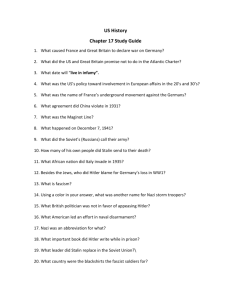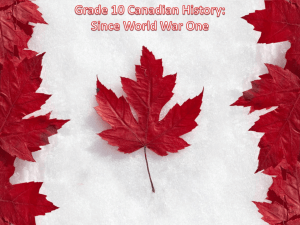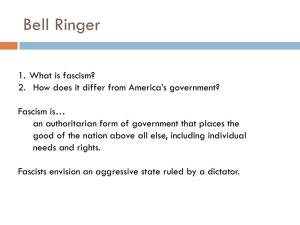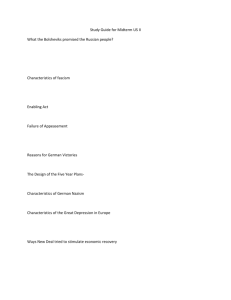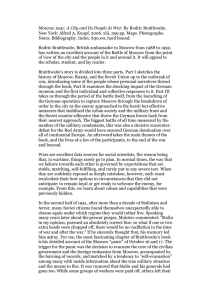Russia in the Anti-Hitler Coalition, Part I
advertisement
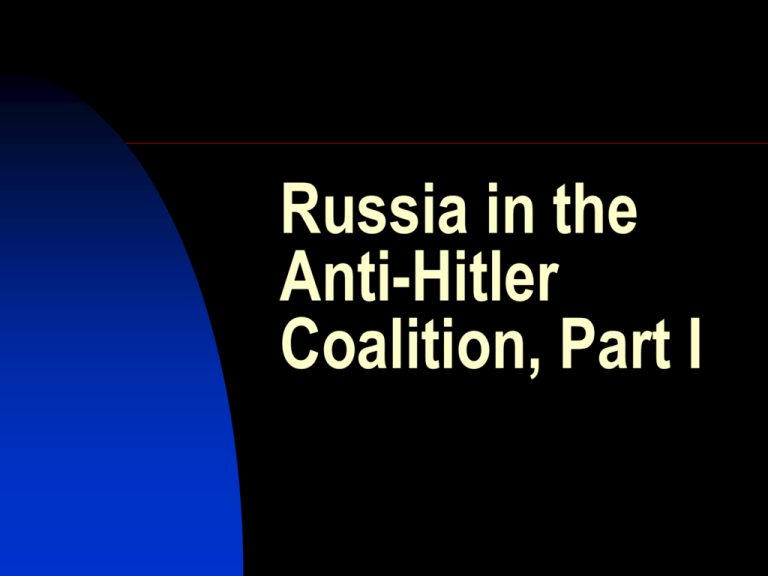
Russia in the Anti-Hitler Coalition, Part I War of the Century, BBC documentary http://www.youtube.com/watch?v= SVo-2jfeoMM&feature=related Spanish Civil War poster Munich, September 30, 1938: Britain and France open door to Hitler’s occupation of Czechoslovakia http://www.youtube.com/watch?v= 0Xd5QtfiXOw Hitler publicly and repeatedly pledged to destroy the Soviet Union, billing himself as saviour of the West from communism As a state committed to world revolution, Russia was viewed as a threat by Western elites The rise of fascism was partly a response to the threat – and anticommunism was one of the motives of Western appeasement of Hitler Stalin saw the prospect of a new world war as an opportunity for the spread of communism: the WWI template But ultimately, WWII was not about revolution: it was an interstate conflict of a traditional kind, similar to WWII, waged on a global scale Britain and France hoped to channel Hitler’s aggression to the East, toward conflict with Russia – reluctant to fight Germany Hitler was determined to prevent Western democracies and USSR from joining forces: beat them one by one Stalin was determined to avoid war with Germany as long as possible – but convinced that such a war was inevitable 1939: A divergence of interests between USSR and Western democracies – and a convergence of interests between Germany and USSR The unexpected deal was logical – but only temporary Moscow, August 23, 1939: German Foreign Minister Joachim von Ribbentrop signs non-aggression pact with Russia Secret Additional Protocol to the German-Soviet Non-Aggression Pact Article I. In the event of a territorial and political rearrangement in the areas belonging to the Baltic States (Finland, Estonia, Latvia, Lithuania), the northern boundary of Lithuania shall represent the boundary of the spheres of influence of Germany and U.S.S.R. In this connection the interest of Lithuania in the Vilna area is recognized by each party. Article II. In the event of a territorial and political rearrangement of the areas belonging to the Polish state, the spheres of influence of Germany and the U.S.S.R. shall be bounded approximately by the line of the rivers Narev, Vistula and San. The question of whether the interests of both parties make desirable the maintenance of an independent Polish States and how such a state should be bounded can only be definitely determined in the course of further political developments. In any event both Governments will resolve this question by means of a friendly agreement. Article III. With regard to Southeastern Europe attention is called by the Soviet side to its interest in Bessarabia. The German side declares its complete political disinterestedness in these areas. Article IV. This protocol shall be treated by both parties as strictly secret. Moscow, August 23, 1939. Stalin offers a toast to Hitler September 1, 1939: Nazi Germany invades Poland German and Soviet invasions of Poland Soviet and Nazi officers in occupied Poland, 1939 May 1940, Dunkirk: British troops evacuated from the continent Hitler and his High Command after occupation of France, summer 1940 1940: Hitler in occupied Paris Hitler and Mussolini in Munich, June 1940 1939-1941: growing tensions between USSR and Germany At first: division of the spoils. But then: Germany’s unexpected triumph in the West emboldens Hitler Hitler’s strategic goal of conquering the USSR was never abandoned – for geopolitical and ideological reasons Stalin expected the new war to generate a new wave of revolutions – and intended to get involved By 1941, his fear of German power became the overwhelming factor He was appeasing Hitler – and preparing for war against him at the same time Each of the two intended to strike first Hitler outfoxed Stalin and delivered a crushing blow 1939-1941: Lowest point in US-Soviet relations since 1933 Roosevelt denounced Stalin USSR viewed as an accomplice to the Nazis Soviet annexation of the Baltic states and invasion of Finland condemned The German invasion of Russia changed everything Operation Barbarossa June 22, 1941 Over 4.5 million troops of the Axis powers invaded the USSR along an 1,800 mile front Goals: Total destruction of the Soviet state Colonization of the Soviet territory, together with allies – Japan especially Enslavement of the population, turning the territory into a resource base for the Third Reich War of the Century,the invasion: http://www.youtube.com/watch?v= StYywx7Uzok&feature=related Hitler explaining the future war against Russia, March 1941: “It is a struggle between two ideologies… Communism presents an enormous danger for the future. A communist has never been and never will be our comrade. It is a struggle for annihilation. If we think otherwise, then, even if we should crush the enemy, the communist threat will rise again in 30 years… This war will be vastly different from the onw in the West. In the East, brutality is a benefit for the future. Commanders must be ready for sacrifice and overcome their doubts.” From the diary of General F. Halder, Chief of Staff, Land Forces, Germany Nazi propaganda poster: SS forces kill the Red beast of communism German poster depicting Soviets: “The lower race” General von Richthoffen in Russia with his officers Celebrating success in Lightning War In the first 10 days, German armies moved 550 km into Soviet territory In the first 20 days of the war, the Red Army lost 1/5 of its manpower – 600,000 men By July, 20 mln. Soviets found themselves under occupation. Nazi terror began. Resistance Redeployment of industry to the East Victims of German occupation Stubborn resistance The Battle of Moscow: September 1941 – January 1942 Moscow, October 1941 Women digging anti-tank moats near Moscow Antitank barriers in downtown Moscow November 7th, 1941: military parade in Red Square Marshal Georgi Zhukov, commander of Soviet forces in the Battle of Moscow Women in the war: medics Women in the war: pilots Children workers assembling weapons Partisans Partisans The Battle of Moscow was the first Soviet victory over Nazi Germany. Casualties in the battle of Moscow: 250,000 – 400,000 German 600,000 – 1,300,000 Soviet

